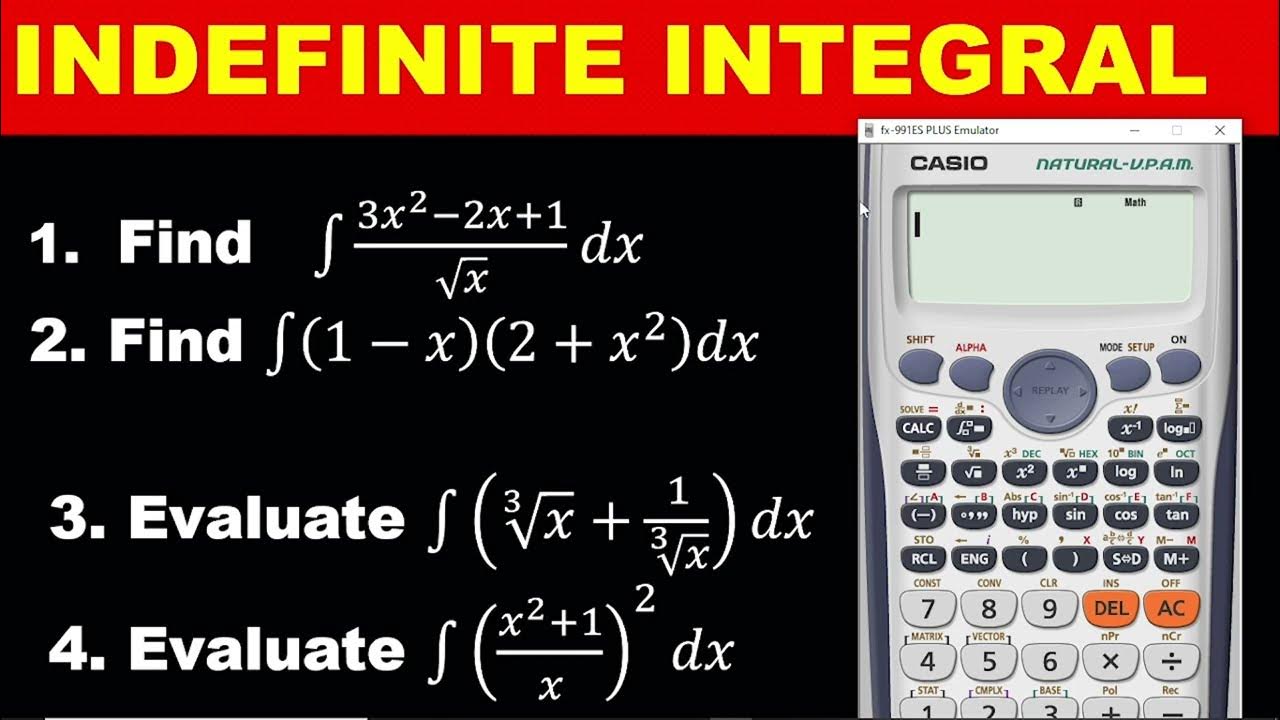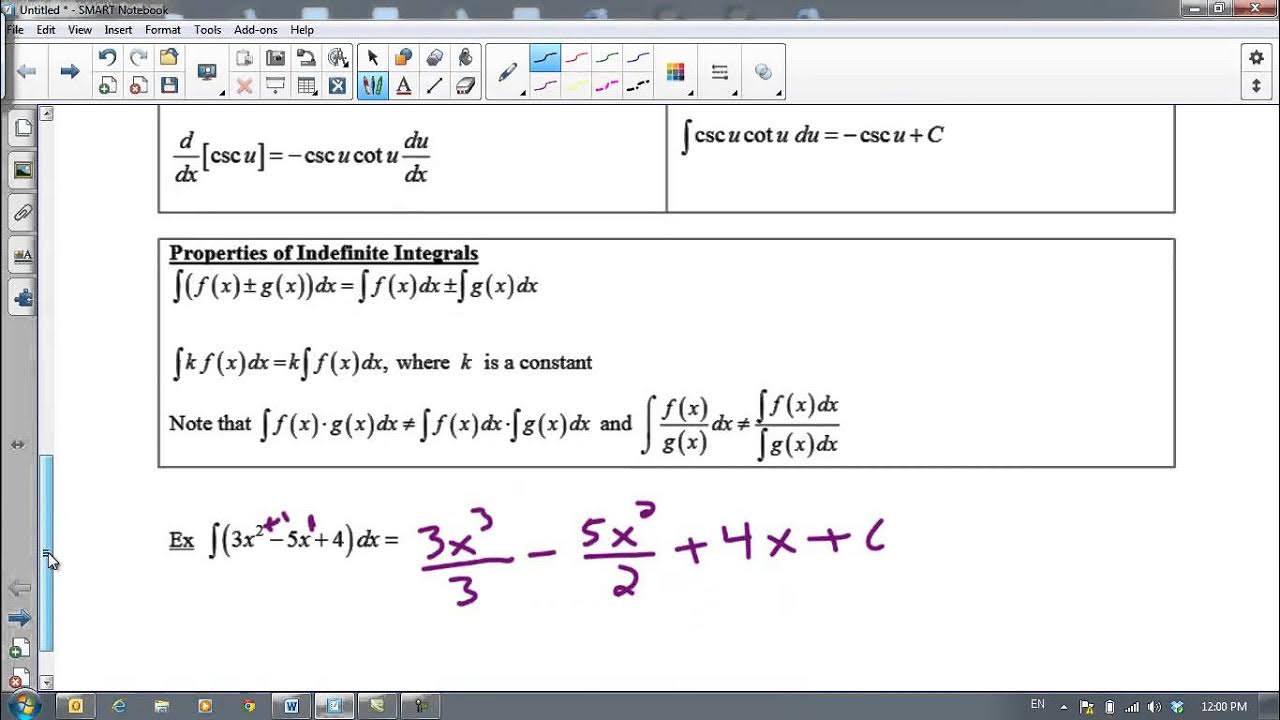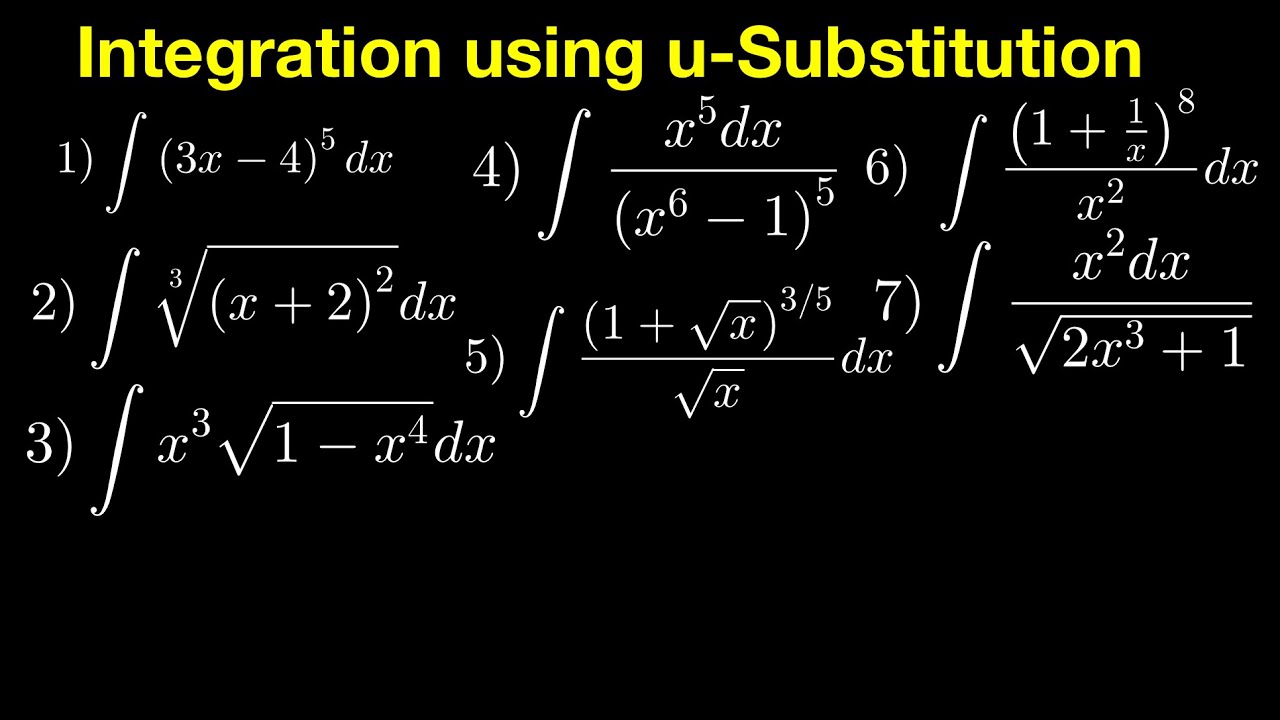Basic Integration Using Power Formula
TLDRIn this informative video, the presenter delves into the fundamentals of basic integration, guiding viewers through the process of integrating algebraic expressions. The video covers various integral formulas, including the power rule, and demonstrates how to apply them to different scenarios, such as integrating monomials and rational expressions. The presenter also explains the concept of the constant of integration and provides step-by-step solutions to several integral problems, aiming to enhance the viewer's understanding of integration techniques.
Takeaways
- 👋 Hi there! This video is your go-to guide for mastering basic integration, especially with algebraic expressions.
- ✍ The fundamental concept of integration taught here begins with the integral of DX, which equals X plus C, highlighting the importance of the constant of integration in indefinite integrals.
- 💻 Through practical examples, the video demonstrates how to integrate expressions with constants, using the property that allows constants to be placed in front of the integral for simplification.
- ⬇ The power rule for integration is introduced, which is a crucial tool for integrating expressions like x squared, x cubed, and beyond, emphasizing that the exponent (n) should not equal -1.
- 📖 A deeper dive into the power formula showcases how even the simplest integrals, such as the integral of DX, can be derived using this approach, reinforcing the foundational principles of integration.
- 🤖 For more complex expressions, such as the square root of x or fractions involving x to a power, the video guides on transforming these into more manageable forms using fractional exponents before applying the power rule.
- ⚡ When encountering integrals involving multiple terms, the strategy of distributing the integral sign to each term and integrating term by term is thoroughly explained, offering clarity on tackling more complex problems.
- 🎯 The video also tackles integrals involving polynomial expressions multiplied by other polynomials, demonstrating how to expand, distribute, and then integrate term by term effectively.
- ✂ Techniques for simplifying expressions before integration, such as expanding squares of binomials and dealing with radicals in denominators, are clearly presented, making challenging problems more approachable.
- ✔ Finally, the importance of applying the constant of integration (+C) in indefinite integrals is emphasized throughout the video, ensuring a comprehensive understanding of basic integration principles.
Q & A
What is the integral of DX?
-The integral of DX is X + C, where C represents the constant of integration.
How do you integrate a constant multiplied by a function, as shown with the integral of 2dx?
-When integrating a constant multiplied by a function, place the constant in front of the integral sign. So, the integral of 2dx becomes 2 times the integral of dx, which simplifies to 2X + C.
What is the power rule for integration?
-The power rule for integration states that the integral of x^n dx is x^(n+1)/(n+1) + C, where n ≠ -1. This formula is used to evaluate the integrals of algebraic functions.
How is the integral of x squared calculated using the power rule?
-Using the power rule, the integral of x^2 dx is x^(2+1)/(2+1) + C, which simplifies to x^3/3 + C.
How can you derive the formula for the integral of DX using the power formula?
-You can express 1 as x^0 since x raised to the power of 0 is 1. Applying the power formula, the integral of x^0 dx becomes x^(0+1)/(0+1) + C, which simplifies to X + C.
How do you integrate expressions involving radicals, like the square root of x?
-To integrate expressions involving radicals, convert them into fractional exponents first. For example, the square root of x can be expressed as x^(1/2), and then you can apply the power rule.
What technique is used to integrate expressions like DX over X cubed?
-For expressions like DX over X cubed, apply the negative exponent law first to transform the denominator into x raised to a negative power, then apply the power rule for integration.
How do you integrate a polynomial function, as demonstrated with the integral of 3x^3 + 2x^2 - x + 5?
-To integrate a polynomial function, distribute the integral sign to each term and integrate term by term, applying the power rule and simplifying the expression.
What method is used to integrate a function multiplied by a constant, such as the integral of 5dx over the cube root of x squared?
-First, place the constant outside the integral sign. Then, express the cube root of x squared as x raised to a negative fractional exponent, and apply the power rule to integrate.
How do you simplify and integrate a complex function like x^3(x^2 - 2)^2?
-First, expand the binomial and distribute x^3 across each term. Then, apply the power rule to each term after distributing the integral sign, and simplify the expression.
Outlines
📚 Introduction to Basic Integration
This paragraph introduces the concept of basic integration, focusing on integrating algebraic expressions. The video begins by explaining the integral of DX, which is the simplest form of integration, and emphasizes the importance of the constant of integration (C) in indefinite integrals. It then proceeds to illustrate how to handle constants in integrals and introduces the power rule for integration, which is a fundamental formula for integrating functions of the form x^n. The explanation includes the derivation of the integral of DX using the power rule and provides a step-by-step approach to solving basic integration problems.
🔢 Integration of Algebraic Functions
This section delves into the integration of more complex algebraic functions, including polynomials and radical expressions. It demonstrates how to apply the power rule to integrate x^n and how to handle integrals with radicals, such as the square root of x, by converting them into fractional exponents. The paragraph also covers the integration of functions with negative exponents, like 1/x^3, and explains the transformation of these expressions into positive exponents using the negative law of exponents. The integration process for each type of function is thoroughly explained, with a focus on the application of integration properties and rules.
📈 Integrating Polynomials and Trigonometric Functions
This paragraph discusses the integration of polynomials with multiple terms, such as 3x^3 + 2x^2 - x + 5, and emphasizes the distribution of the integral symbol across each term. It also introduces the integration of trigonometric functions, specifically focusing on the square root of x, and explains how to handle radical expressions in the denominator. The process of integrating each term individually and then combining the results is detailed, along with the application of the power rule to each component. The paragraph concludes with the final integrated form of the given polynomial and trigonometric function.
🧮 Complex Integration Techniques
This section presents advanced integration techniques for handling more complex expressions, such as products and quotients of functions. It explains how to simplify expressions before integration, using the example of x^3(x^2 - 2)^2. The paragraph outlines the process of expanding binomials, distributing the integrand, and integrating term by term. It also covers the integration of expressions with negative exponents and radicals in the numerator, providing a step-by-step guide on how to transform and simplify these expressions using the power rule and properties of exponents. The final integrated form of the complex expression is presented, highlighting the application of various integration rules and techniques.
🎓 Summary and Conclusion
In conclusion, the video provides a comprehensive overview of basic integration, covering a range of techniques from simple to complex integration problems. It emphasizes the importance of understanding the power rule, handling constants, and managing negative exponents and radicals. The video also encourages viewers to practice these integration techniques to solidify their understanding. The presenter expresses hope that viewers have gained valuable knowledge from the video and thanks them for their attention and participation.
Mindmap
Keywords
💡Integration
💡Indefinite Integral
💡Constant of Integration
💡Power Rule
💡Algebraic Expression
💡Fractional Exponents
💡Negative Exponents
💡Binomial
💡Complex Fraction
💡Term-by-term Integration
Highlights
Introduction to basic integration and its application in evaluating integrals of algebraic functions.
Explanation of the integral of DX, which is equal to X plus C, where C represents the constant of integration.
Discussion on the property of integrals where a constant can be factored out and multiplied by the integral of the function.
Introduction to the power rule for integration, which states that the integral of x^n dx equals (x^(n+1))/(n+1) + C, with the caveat that n should not be equal to -1.
Derivation of the integral of DX as X plus C using the power rule and algebraic manipulation.
Explanation of how to handle radicals in integrals by converting them into fractional exponents.
Integration of functions with negative exponents by applying the negative law of exponents and the power rule.
Method for integrating a constant over a radical expression by applying the power rule and simplifying complex fractions.
Process of distributing the integral symbol to each term in a polynomial and integrating term by term.
Expansion of binomials and distribution of terms in the integral for more complex expressions.
Integration of terms with the same base by applying the division law of exponents.
Explanation of how to handle integrals with a radical in the denominator by transforming it into a fractional exponent.
Demonstration of integrating a binomial squared by expanding it and applying the power rule to each term.
Integration of a complex expression involving a combination of terms with different exponents and roots.
Final summary of the video, emphasizing the learning outcomes and thanking the viewers for their attention.
Transcripts
Browse More Related Video
5.0 / 5 (0 votes)
Thanks for rating:





